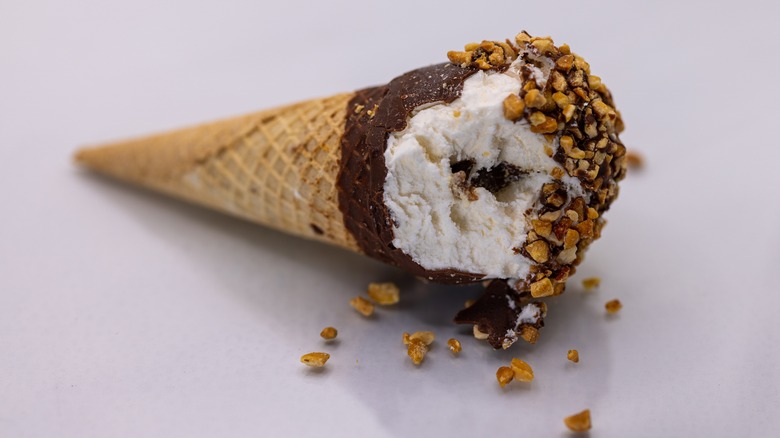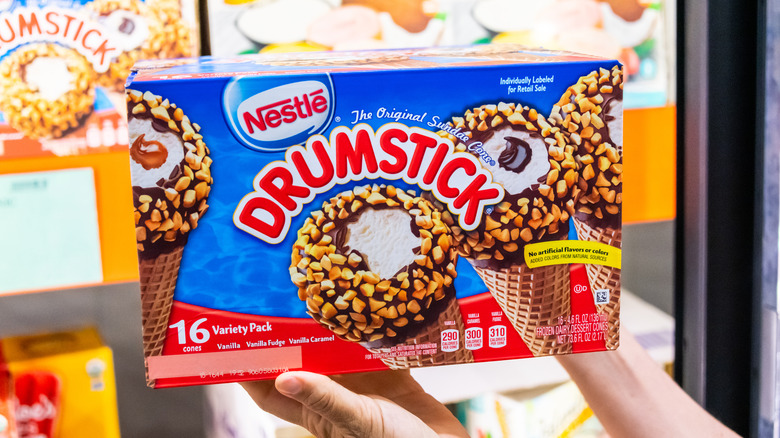Drumsticks Don't Melt Like Ice Cream Because They Aren't
We all have our food weaknesses. Maybe it's a certain toastable pastry, or a particular brand of chips, or even a beloved frozen ice cream cone you've been buying ever since you could run outside for the ice cream truck: the Nestlé Drumstick. Those crunchy sugar cones filled with creamy vanilla ice cream and coated in a chocolate shell and a generous amount of toasted peanuts are truly irresistible. And, of course, there's the pièce de résistance: that puddle of chocolate that pools and solidifies at the very bottom of the cone, making for a memorable finale.
We'd certainly hate to crush your sugar dreams, or make a part of your inner child grow up, but it turns out that this timeless, summertime treat isn't really ice cream at all. The revelation comes after TikTok user @olliebubs09 posted a short video that went viral, showcasing a Drumstick cone left out at room temperature for nearly a day. Surprisingly, the frozen treat never fully melted, making viewers wonder what in the frozen food aisle was going on? It all has to do with what's on the label.
According to the U.S. Food and Drug Administration, a product has to contain at least 10% milkfat to be considered and labeled "ice cream." Yet, on a package of Drumsticks, you'll instead find the words, "frozen dairy dessert" — AKA, "go ahead, try to melt me!"
Why won't Drumsticks melt?
There are plenty of ingredients in Drumstick cones that sound like they belong in such a food, like sugar, skim milk, chocolate, and salt; we'll even give "dairy product solids" a pass. But there are also a lot of "-ylenes," "monos," and "-glycerides" going on. The ingredients that truly make these cones so temperature-stable are the gums, however. Certain types of gums in foods are added to emulsify and stabilize food, and that includes keeping frozen desserts from rapidly melting. Drumsticks contain guar gum, carob bean gum, and cellulose gum, all of which explains the treat's immortality.
Such a phenomenon isn't limited to Drumsticks, either; people have found that the "ice cream" in certain ice cream sandwiches and bars has a hard time acting like real, melting ice cream as well. Despite the additives, it's possible that frozen dessert giants like Nestlé have a method to their madness. Perhaps using real ice cream would melt faster than people could eat it? Or, maybe taste testers simply liked what the ingredients did to the texture. Besides, some agree that the additives aren't as harmful as others would believe.
How bad could 'frozen dairy dessert' be?
Dr. Joe Schwarcz is the Director of the Office for Science and Society at Montreal's McGill University, and he suggests that there is nothing unsafe about the kinds of additives that are used in frozen dessert products like Drumsticks. In an article he wrote in 2017, he pointed out that many of the additives are obtained by completely natural sources, like beans and naturally occurring fats.
Obviously, a diet that's too high in sugar and calories could lead to health concerns, but, according to Schwarcz, such treats shouldn't be outright vilified based on the opinions and assessments of internet sleuths and those seeking click conversions.
This is good news for many who'd rather not be shamed into never eating a Drumstick again. After all, these nostalgic cones are a little piece of Americana, conceptualized at the 1904 World's Fair and putting messy, "ice cream"-covered smiles on the faces of kids (and kids at heart) for generations.


